William Alfred Souter at the age of 26 years in 1906 had formed the Sheaf Steam Shipping Co. Ltd. with a capital of £8,000, and ordered his first ship from the Blyth Drydocks and Shipbuilding Co. Ltd. He was the son of parents Charles William Souter (1856-1944) and Clara Wilkinson Souter (1859-1937). He could trace his shipmaster ancestors as far back as 1715, and being born and bred in Sheffield he named the company after the river Sheaf which runs through the city with seven hills. He had obtained his first job on Newcastle Quayside in 1896 as an apprentice with Jacques Hawkes-Smith & Co. He joined William Dickinson & Co. Ltd., shipowners, in 1899, before leaving in 1906 to set up his own shipowning company. Sheaf Field of 2,650 dwt was ready in 1906 at Blyth and was employed in the Baltic, Biscay and Mediterranean trades. He also operated five small steamers of up to 1,850 dwt on charter in the summer season between 1908 and 1912 from Morocco and Spain with barley.
The first four years of the company were not altogether successful, there was no dividend for shareholders in the first two years, with only 2.5% in the third year and 2% in the fourth year. However, an improvement in freight rates occurred which provided capital for expansion. In 1911, the Sheaf Arrow Steamship Co. Ltd. was formed to own the fast, self-trimming collier Sheaf Arrow of 3,120 dwt. She was of the ‘Arch-Decker’ design by naval architects and designers Ayre and Ballard, and was another non-conventional tramp ship design, including the ‘Turret’ tramp designed to lower the Suez Canal toll charges. The ‘Arch’ was both a longitudinal and transverse one with the bow and stern slightly lower than the middle of the ship. The extra strength given by this arch permitted longitudinal beams and hold pillars to be dispensed with to give an unobstructed space in the holds for the carriage of cargo.
Sir Amos Ayre (1885-1952), founder of the Burntisland Shipbuilding Company, and born at South Shields and served his apprenticeship with the Wood, Skinner & Co. Ltd. yard at Gateshead, and Maxwell Ballard (1876-1947), Managing Director of the Northumberland Shipbuilding Company at Howdon-on-Tyne devised a new patented system of tramp design giving a reduction in the weight of steel and outfitting material over a conventional ‘three island’ tramp steamer. A weight saving of 309 tons of steel and 49 tons of outfitting material gave a lower construction cost for a tramp of 4,898 dwt with a draft of 20.6 feet, as well as a saving in coal consumption due to the lower weight, over tramps built to a conventional single deck style with fo’c’stle, bridge and poop compared to an identical steamer of the same deadweight and draft of an ‘Ayre-Ballard’ design with only fo’c’stle and poop.
The ‘Arch-Decker’ Sheaf Arrow made good profits and was almost the last ship to leave Hamburg in August 1914 on the outbreak of war. She had arrived there with a full cargo of Tyne coal on 2nd August and the cargo was completely discharged on that day. Capt. T.B. Clarke sailed immediately and arrived back in the Tyne at 0600 hours on the 5th August
In October 1914, the company purchased the small Norwegian steamer Ella of 1,350 dwt, and in the following month a tramp from Needham Brothers of West Hartlepool which was renamed Sheaf Blade. The capital of the company was then raised to £60,000, and four second-hand tramps of around 5,000 dwt were purchased later in the war and renamed Sheaf Dart, Sheaf Brook, Sheaf Lance and Sheaf Spear. War losses during the war amounted to only the small steamer Ella on 5th December 1916 in the North Sea, and Sheaf Blade torpedoed and sunk 17 miles SSE of Cape Gata on the Mediterranean coast of Spain on 25th October 1917. The latter ship was on a voyage from Messina to Almeria in ballast, with two crew killed. The managed steamer Dronning Maud was torpedoed and sunk 65 miles from Cape Sigli in Algeria while on a voyage from Sunderland to Malta with coal, one crew was lost.
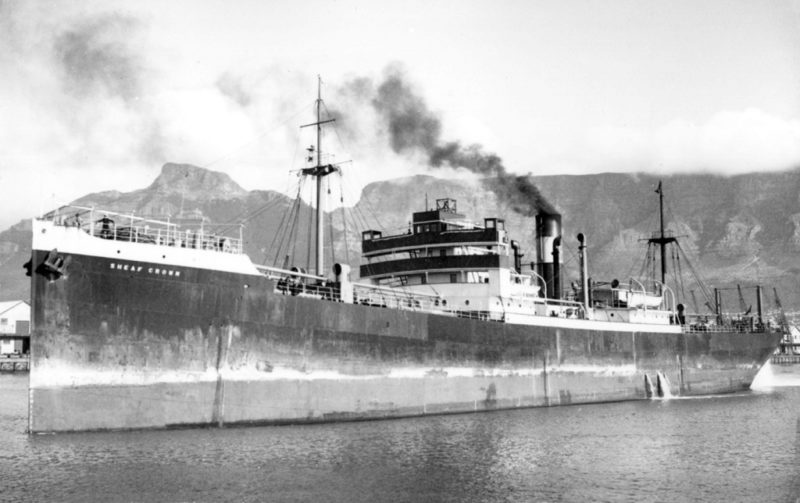
In February 1919, the capital of the company was again raised to £150,000 with the issue of 90,000 new shares at £1.25 each, with all of the shares being fully subscribed. This enabled William Souter to purchase in May 1919 the Andrew Weir tramp Gifford, which had been interned at Hamburg on the outbreak of war, and she was renamed Sheaf Mount. The registered office of the company at this time was at Akenside House on Akenside Hill in Newcastle, with Joseph R. Scott & Son of Milburn House as Superintendent Engineers.
In 1920, the capital of the company was raised again to £450,000 and the nominal capital to £300,000 by giving bonus shares on the basis of one for one. The fleet now comprised eight tramp steamers and colliers as follows:-
- Sheaf Arrow of 3,140 dwt built in 1912 by Blyth Shipbuilding & DD Co.
- Sheaf Dart of 5,000 dwt built in 1905 by Wm. Gray of West Hartlepool
- Sheaf Don of 3,140 dwt built in 1917 by Blyth Shipbuilding & DD Co.
- Sheaf Field of 2,600 dwt built in 1906 by Blyth Shipbuilding & DD Co.
- Sheaf Lance of 5,050 dwt built in 1918 by Blyth Shipbuilding & DD Co.
- Sheaf Mead of 7,590 dwt built in 1915 by Wm. Gray of West Hartlepool as Hawksker
- Sheaf Mount of 9,350 dwt built in 1913 by Wm. Doxford of Sunderland
- Sheaf Spear of 5,050 dwt built in 1919 by Blumer of Sunderland
However, the post war boom in freight rates soon ended and the company began to experience financial difficulties, making it necessary to half the capital by issuing 10 shilling shares. The management company of W.A. Souter & Company was made into one of limited liability in 1921 with a capital of £25,000, the first directors being William Alfred Souter, John Cowley Robson and A. H. Arnesen, shipping clerk.
The policy of the company was to operate in both the deep-sea and North East Coast coal trades. Four ‘Arch-Deck’ colliers of 2,600 dwt were ordered from the Blyth yard and were completed as Sheaf Garth, Sheaf Field, Sheaf Crest and Sheaf Water between 1921 and 1924, with a further collier from the Burntisland yard as Sheaf Brook. The company showed small losses between 1922 and 1925, and extra revenue was sought by managing two tramps, Neptunian and Titanian, for their owners and builders of Swan, Hunter & Wigham Richardson Ltd., and the collier Wynding built in 1922 was purchased. Trimming costs of coal cargoes were essential to prevent the cargo shifting, and other operating costs were compared by a new steam tramp and a new motor tramp on the completion of Sheaf Holme (motor) and Sheaf Crown (steamer) in Autumn 1929. Sheaf Holme had another claim to fame, as she was the first tramp fitted with McGregor steel hatch covers.
At the onset of the Depression, the fleet numbered fifteen tramps and colliers of 86,200 dwt. No financial loss was made in any of the slump years, but no dividend was paid for seven years and the management company forego all charges. Sheaf Garth was laid up in the Tyne and four older tramps were sold off, and the staff moved to cheaper premises at 24/26 The Side near Newcastle Quayside. Sheaf Brook foundered on 20th November 1935 when 110 miles ESE of the Tyne while on a voyage to Hamburg from the Tyne with coal, and all hands were lost. She had sailed from Dunston Staithes in the early hours after having left dry-dock the day before. It was a typical winter night and as darkness wore on the wind rose to gale force. Just after midday she took a dangerous list to port and the wireless cabin started to flood, the last message being sent before the transmitter failed. Sheaf Water and several ships hurried to her aid, and three distress rockets were seen but the ship sank soon afterwards. Sheaf Water and the Hull tug Superman continued searching all the next day until an upturned lifeboat was found along with other wreckage. Further wreckage from the second marine casualty of the company washed ashore at Bridlington. The first marine loss was Sheaf Don wrecked in 1926 near Langesund in Norway while carrying coal from the Tyne.
Three of the ‘Arch-Deckers’ were put on the sugar trade during the Depression between the Caribbean and the Eastern Seaboard of the U.S.A. to keep them fully employed. Sheaf Crest had an unusual voyage in 1933 carrying timber from Vancouver to Miami after hurricane damage in Florida. The collier was especially suitable because Miami could not take a ship drawing more than 19 feet, and the timber sold at a very high price because of the demand caused by the hurricane. Sheaf Lance was fixed on time charter on the other side of the world to carry coal from Chinwangtao in North China to ports further south in China.
On 10th February 1934, Sheaf Holme sailed from Hamburg after dry-docking and painting at the start of a very long voyage of 811 days, as follows:-
Hamburg (soya beans), Wilmington (ballast), Panama, Iquique (nitrate), Hawaii (ballast), British Columbia (timber), Cape Horn, Durban, Lourenco Marques (ballast), Adelaide (wheat), Shanghai (ballast), British Columbia (timber), Melbourne, Sydney (NSW) (general), Fiji, Samoa, Vancouver (timber), Tahiti, Rarotonga, Mauke Island (Cook Islands), Wellington (New Zealand), Melbourne, (general), Sydney (NSW) (general), Fiji, Samoa, Vancouver (timber), Samoa, Melbourne, Beauty Point (Tasmania), Port Huron (Michigan), Sydney (NS) (wheat), Belfast, Dublin, Tyne.
The Pacific trading was especially refreshing for her crew, who knew full well there were two hundred tramps laid-up on the Tyne.
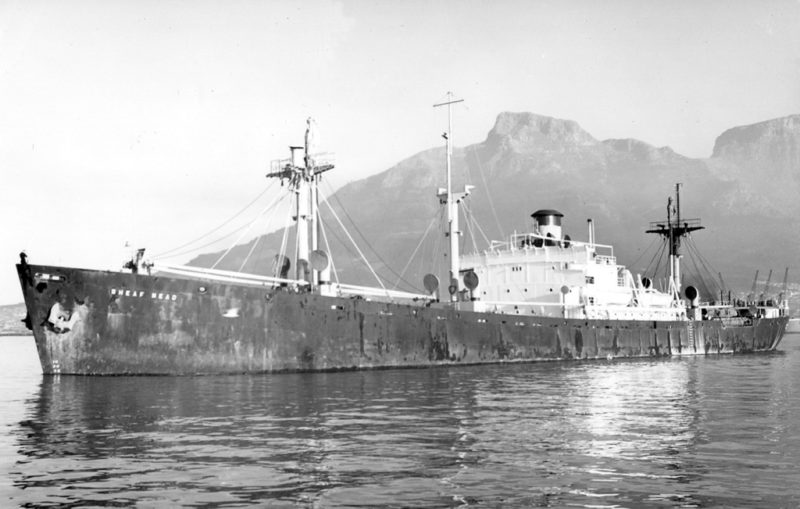
Late on 23rd April 1935, the managed motor tramp Titanian hit an iceberg while on a voyage from the Tyne to Canada to load cargo. She suffered damage to the bottom of her bow, and an S.O.S. was sent off to Cape Race and St. John’s with her name and position. The crew then discovered that they were in the exact same position as the four funnelled White Star Line Titanic at 41°66′ North, 50°14′ West some 270 miles SE of Cape Race. The similarity of the names of the ships was also a portent of what might happen, but her propeller remained free and she reversed out of danger. The bulkhead in number 1 hold was shored up as a precaution, but she became hemmed in by ice. The sealer Caribou turned up just when hope was beginning to fade, but it took two tow ropes, the other from the sealer Imogen, to get her clear of the ice. Imogen kept on pulling and eventually towed the lucky tramp into St. John’s on 30th April 1935.
The Hebburn Steamship Co. Ltd. was formed in November 1934 and acquired for £12,250 the second-hand self-trimming collier Hebburn of 4,400 dwt, built for the Burnett Steamship Company of Newcastle in 1924. The tramp Hylton of 9,285 dwt was completed in 1937 from the William Pickersgill yard in Sunderland under the Scrap & Build Scheme of 1935. On the outbreak of war on 3rd September 1939, the Souter fleet owned four deep sea tramps, Sheaf Crown, Sheaf Holme, Sheaf Mount (purchased in 1939) and Hylton, and four colliers, Sheaf Field, Sheaf Crest, Sheaf Water, Sheaf Don. Shortly after the outbreak, the small Norwegian collier Fredville was purchased and was similar to Wynding, as well as two Glasgow tramps Gretaston and Luciston from William S. Miller & Company. A dozen owned and managed ships were lost to enemy action in World War II:-
- Sheaf Crest mined and sunk on 30th November 1939 north of North Foreland while on a voyage from the Thames to the Tyne in ballast, one crew lost.
- Fredville torpedoed and sunk on 11th January 1940 NE of Buchan Ness while on a voyage from Drammen to Methil in ballast, 10 crew lost.
- Sheaf Mead (ex Gretaston) torpedoed and sunk on 27th May 1940 NW of Cape Ortegal in north west Spain by U-37 while on a voyage from Swansea to Philadelphia in ballast, 31 crew lost out of a total crew of 36.
- Neptunian torpedoed and sunk on 7th September 1940 by U-47 (Prien) south of Iceland while on a voyage with sugar from Santiago de Cuba in convoy SC52, all hands lost.
- Empire Ocelot torpedoed and sunk on 28th September 1940 south of Iceland while on a voyage from Liverpool to Philadelphia and Baltimore in ballast, 2 crew lost.
- Sheaf Field mined and sunk 2 miles SW of Sunk Light Vessel on 28th October 1940 while on a voyage from the Tyne to London with coal, crew of 26 saved.
- Hylton torpedoed and sunk on 29th March 1941 south of Iceland while on a voyage from Vancouver to the Tyne with timber and wheat, all crew saved.
- Empire Springbuck torpedoed and sunk on 10th September 1941 East of Cape Farewell, all hands lost in convoy SC42 while on a voyage from Boca Grande with steel and explosives.
- Empire Guillemot lost to an aircraft torpedo on 24th October 1941 West of Galeta Island while on a voyage from Malta to Gibraltar, 10 crew and one gunner lost, the remainder were interned.
- Empire Gemsbuck torpedoed and sunk on 3rd November 1941 off Labrador while on a voyage from Philadelphia and Sydney (NS) to Londonderry with machinery and general, all crew saved.
- Sheaf Mount torpedoed and sunk in mid Atlantic on 24th August 1942 while on a voyage from Swansea and Milford Haven to Botwood (Newfoundland) in ballast, 28 crew and 3 gunners lost.
- Sheaf Water torpedoed and sunk by E-boat S-46 on 7th October 1942 off North Norfolk while on a voyage from London to Sunderland in ballast, crew saved.
The war claimed 183 lives lost on the company ships, with some of these in the 26 foreign colliers and tramps managed for the Ministry of War Transport, including Danes, Swedes, Norwegians, Greeks, Estonians, Latvians and Belgians. The standard 4,100 dwt collier Empire Ness was also managed with a view to purchase after the war, but she was lost on 30th November 1944 in a collision with a ‘Liberty’ ship in the Scheldt estuary. Capt. Watson O’Connell was rescued with most of his crew from Hylton, and they were transferred to the managed old, slow American built tramp Empire Springbuck at Sydney (NS) for the voyage home. She was carrying steel and explosives from Boca Grande but all of her crew and the survivors from Hylton were lost when Empire Springbuck also was sunk.
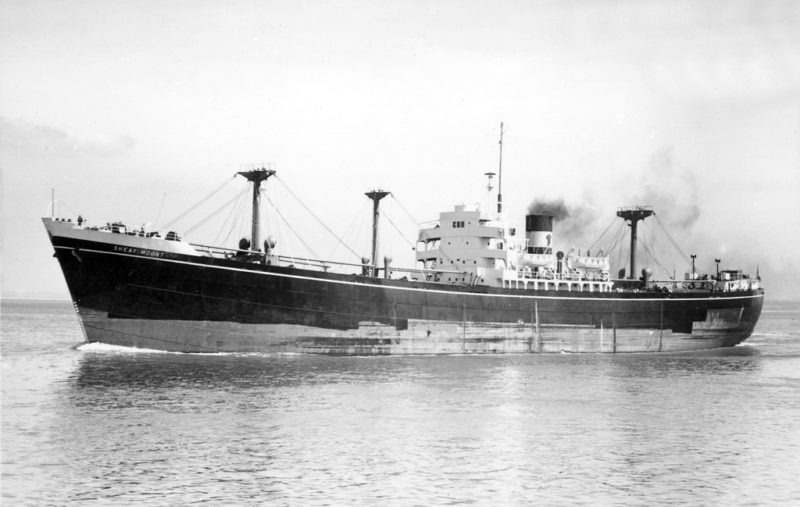
The managed Neptunian left Santiago de Cuba with sugar on 30th July 1940 and then waited several days at Sydney (NS) before picking up homeward bound convoy SC2 of 53 ships. A wolf pack of several U-boats commanded by aces such as Prien, Kretschmer and Kuhnke caught up with them, and Neptunian disappeared during the night of 7th September to a torpedo from Prien in U-47 and all of her crew and one gunner were lost. Sheaf Mount had been repaired after bomb damage sustained in the North Atlantic on Christmas Day 1941, and was outward bound in ON122 in August 1942 under Capt. De Gruchy when she was struck by one or more torpedoes of a spread of five fired by U-605. Sheaf Water was torpedoed and sunk by E-boat attack to NE of Cromer on 7th October 1942, while Sheaf Crown was torpedoed and damaged on 4th March 1943 a few miles off the South African coast south of Durban, but made port safely where repairs took a year.
EXPANSION INTO NEW TRADES
The sister tramps Sheaf Crown (steamer) and Sheaf Holme (motor ship) dating from 1929 were the only pre-war survivors, as Sheaf Don had been sold to Irish owners. An ‘Empire’ type and a ‘Liberty’ type were then purchased and renamed Sheaf Mount and Sheaf Mead. Two standard ‘Fort’ types of 10,000 dwt were bareboat-chartered for two years each. Two standard war-built colliers of 2,900 dwt were purchased in 1948 after having been on bareboat-charter to the company for five years, becoming Sheaf Arrow and Sheaf Field.
An analysis of the 58 voyages of Sheaf Arrow in a three-year period from June 1948 shows she made two dozen coastal voyages with coal from North East Coast ports to London, and 34 voyages to near Continental and Baltic ports. She made only one Mediterranean voyage to Ceuta in Spanish North Africa, but this was marred by a stranding at Cape Trafalgar, but fortunately she came off undamaged and loaded ore at Marbella for Ijmuiden. She was the last owned collier in the fleet and made her last voyage for the company in October 1956, and was then sold to Norwegian owners and renamed Eva. Sheaf Field, her sister collier, was sold in 1952 to William Cory & Sons Ltd. and renamed Corfield.

On the deep-sea tramp side of the business, the steamer Sheaf Crown and her motor sister Sheaf Holme were sold off after only a few years of post-war service, the steamer went to Greeks in 1947 and the motor tramp ironically to the country that had tried so hard to sink her during the war, Germany. After the sale of the ‘Liberty’ type Sheaf Mead in October 1951, the ‘Empire’ type Sheaf Mount sailed on alone until 1957 when sold to Dornoch Shipping Co. and was renamed Valldemosa. The company was thus left without a dry cargo tramp, but two sister tramp tankers of 18,600 dwt were completed by the J.L. Thompson yard at North Sands, Sunderland as Sheaf Royal in 1953 and Sheaf Holme in 1955.
At the beginning of 1956, the company decided to enter the iron ore trades and ordered five of six ore carriers from Sunderland yards, two for the Sheaf company, and four for a new company, Bamburgh Shipping Co. Ltd., of which Sheaf owned 51% and the British Iron & Steel Corporation (BISCO) the remaining 49%. They were delivered during 1959/61 as Sheaf Field, Sheaf Wear, Bamburgh Castle, Lindisfarne, Longstone and Cheviot. The four Bamburgh owned ore carriers had fifteen year charters to Bisco, whereas the two Sheaf vessels had ten year charters to BISCO and were sold off in 1969.
On 5th July 1963, the founder Sir William Alfred Souter, then aged 83 years but still an active Chairman, and his sons David and Douglas Souter, directors of the company, issued a statement confirming that the company had entered into a contract with J.L. Thompson & Sons Ltd. for the construction of a bulk carrier of 34,000 dwt suitable for the coal, iron ore and grain trades. Opportunity had been taken to use Government finance, and 80% of the cost of the vessel was repayable over ten years at a reasonable rate of interest. The 80% Government payment would not be made until the vessel was delivered, so the company had to make suitable arrangements with its bankers to make the usual staged payments to the builder. The Wear yard had won the order against stiff competition from home and abroad, and Sir William went on to say, “During the last eight years a great change has taken place in the carriage of bulk cargoes with the introduction of larger and still larger vessels with greater carrying capacity and proportionately lower operating costs to lower the cost of transport. In order to accommodate these larger bulk vessels, more ports throughout the world are providing deeper depth of water, and there is little doubt that this process will continue. The directors consider it essential that the company should possess a vessel of much larger size to take advantage of these enormously changed conditions”.
This bulker was Sheaf Mount of 37,655 dwt and was delivered in April 1965, and an order was placed at the same time with the same builder for the bulker Sheaf Tyne of 52,000 dwt to be delivered in July 1967. This pair voyaged worldwide in the iron ore, coal and Chilean nitrates trades until Sheaf Tyne was sold to an Israeli company within Overseas Shipholding Group (OSG) and renamed Har Camel in late 1972. She made her last voyage for the company from Baton Rouge to Ghent with grain, but her scheduled call at Tilbury was cancelled. This would have been her first call at a U.K. port in seven years since sailing from Sunderland.
Sir William A. Souter, the founder, died at the age of 89 years on 22nd December 1968 and was buried in Jesmond Old Cemetery in Newcastle. The late 1960s was the time for new ‘Liberty’ ship replacements, and the company ordered an engines aft version of 15,000 dwt from Sir James Laing on the Wear, and she was delivered as Sheaf Crest on 3rd June 1968. She sailed on her maiden voyage for Hamburg, where she loaded steel plates and wire for Walkom in Finland. However, while sailing from Hamburg she was in collision in the Elbe estuary with the Greek tanker Virginia and sustained severe bow damage. A repeat sister ship was ordered from the South Shields yard of John Readhead & Sons Ltd. as the Wear yards were full of work for delivery in March 1971 as Sheaf Field.
The giant bulker Dunstanburgh Castle of 101,605 dwt was completed by the Furness Shipbuilding yard on the Tees in March 1970, and was trading at the end of 1971 with the rest of the Souter fleet as follows:-
- Dunstanburgh Castle was trading from Pepel to Ijmuiden with iron ore although stern gland trouble necessitated repairs at Palermo.
- Sheaf Mount was at Constantza unloading coke from China. She had regularly traded that year between Vancouver and China calling at Japan.
- Sheaf Tyne was discharging iron ore at Duluth from San Nicolas in Peru, and had regularly traded that year from Peru to Japan and the U.S.A.
- Sheaf Crest sailed from the Great Lakes for Japan via Panama, and had regularly traded that year from the Great Lakes, with one voyage to Port Sudan and Basrah, and on to Australia via Durban for bunkers to load grain for Montreal.
- Sheaf Field sailed from Quebec to Calcutta, and had regularly traded that year from the Great Lakes to Scandinavia.
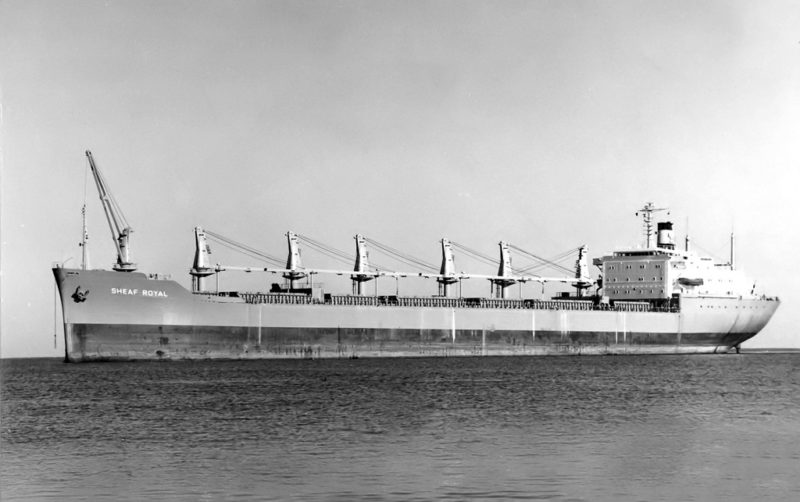
The funnel colours of the Bamburgh Shipping Co. Ltd. were black with a red castle on blue over yellow bands, and their hulls were grey. The Sheaf Steam Shipping Co. Ltd. ships had black funnels with a yellow wheatsheaf on a blue band, and their hulls were grey with red boot-topping. The ore carriers Bamburgh Castle, Cheviot, Longstone, and Lindisfarne were on long term charter to BISCO, and continued on their familiar routes from the iron ore ports of Narvik, Murmansk, Port Cartier, Vitoria and Seven Islands to U.K. blast furnace ports. Three chemical tankers were managed in the 1970s for Stolt-Nielsen in Stolt Sheaf of 25,060 dwt, and the sisters Stolt Castle and Stolt Crown of 18,130 dwt. Three bulkers were managed in the 1970s for Whitwill, Cole & Co. Ltd. of Bristol in British Wasa of 18,267 dwt, Scottish Wasa of 15,920 dwt, and Irish Wasa of 15,440 dwt, the latter being the former owned Sheaf Wear ore carrier built on the Wear in 1959, and which caught fire off Coruña on 14th February 1977 while on a voyage in ballast from Glasgow to El Ferrol, and was broken up at Bilbao two months later.
Sheaf Royal was a geared bulker of 38,000 dwt when completed at the Landskrona yard in Sweden in 1972, and she sailed on her maiden voyage from Casablanca with phosphates to Tsamkong in China, discharging her cargo with her own gear. She was registered under a new company, Sheaf Navigation Co. Ltd.
The ‘Liberty’ replacement Sheaf Crest was in collision again in 1973, this time at Rotterdam, where a rogue ship had broken loose from her moorings, with her damage plus faulty alternators was repaired at South Shields. The new 106,000 dwt bulker Alnwick Castle was launched appropriately by the Duchess of Northumberland, and was completed in April 1974 at the Walker Naval Yard of Swan Hunter Shipbuilders Ltd. She was chartered for seven years to Australian National Line, whose funnel colours she wore. She had an Australian crew to comply with Australian cabotage and protectionist rules for ships trading around Australian coasts, and was stored and managed in Australia. She made her maiden voyage from the Tyne to the Mississippi, and loaded grain there for the Continent, before sailing to Australia.
Orders were placed in 1974 for a new bulker of 65,000 dwt from Burmeister & Wain Ltd. in Copenhagen for delivery in August 1976, and for a 71,600 dwt Panamax bulker from Sunderland Shipbuilders Ltd. for delivery in 1978 at a cost of £9 million. The first bulker was launched as Sheaf Crest but completed as Ros Castle for the Bamburgh Shipping Co. Ltd., while the latter bulker was completed as Benhope for Ben Line.
Ben Line of Edinburgh had made an offer in December 1976 of 115 pence per share for the shipping subsidiaries of the company, which was accepted by the directors. The company from this date were solely managers of ships, which under the terms of the offer, was to carry on for another three to four years under company management before passing to Ben Line. At the same time, the management company of W.A. Souter & Co. Ltd. was taken over by Burmeister & Wain of Copenhagen, who purchased all of the fixed assets of the agency, management and forwarding departments of the company. These then traded under a new company, Souter Hamlet Ltd., and at first all directors, staff and sea-going personnel were taken on by the new company. This company went on to manage new B & W bulkers and ships amongst many other ships owned by many different companies.
The voyage position of the owned fleet in December 1976 when it was sold was as follows:-
- Sheaf Tyne was discharging grain at Gdynia from the U.S.A., and was sold off by Ben Line in 1978.
- Sheaf Field was on charter to P. & O. Shipping, having sailed from the U.K. to the Persian Gulf and then on to Port Louis in Mauritius to load sugar, and was sold off by Ben Line in 1979.
- Sheaf Royal was en-route from Australia with grain for the Continent and for a spell in dry-dock at Antwerp. She was renamed Benvorlich in 1978 and was sold off by Ben Line in 1984.
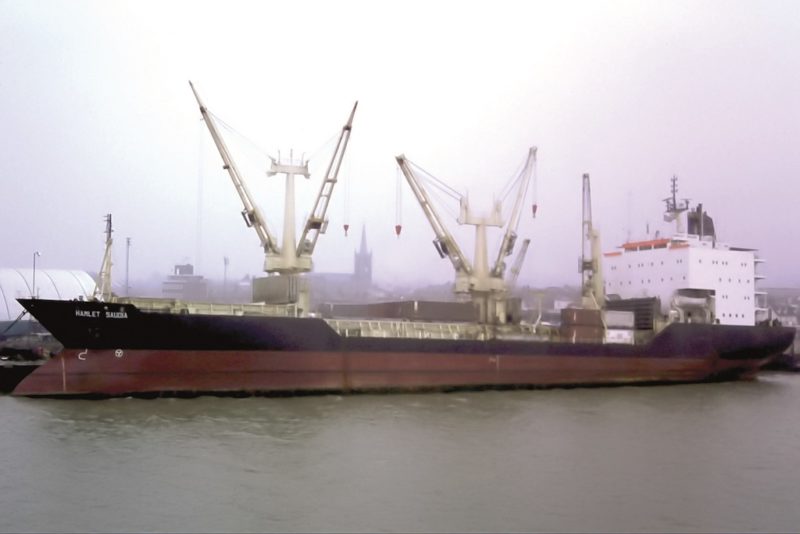
MANAGED SHIPS of SOUTER HAMLET Ltd. and SOUTER SHIPPING Ltd.
Well over thirty ships of many types were managed by Souter management during the 25 year period from 1977 to 2002 at their headquarters in Clayton House, Regent Centre at Gosforth in Newcastle. Douglas Souter, David Souter, and Richard Ian Douglas Souter were the Managing Directors over this long period, together with three other directors. These managed ships were:-
- Ros Castle, bulker built in 1976 as Sheaf Crest of 35,706 grt and 65,088 dwt was half owned by the Bamburgh Shipping Co. Ltd. and half by her charterer British Steel and could not be sold until the end of her charter. This occurred on 16th January 1981 when she arrived at Rotterdam from Monrovia, she was renamed Benledi by Ben Line.
- Dunstanburgh Castle completed in March 1970 of 101,605 dwt by the Furness Shipbuilding yard on Teesside was half owned by the Bamburgh Shipping Co. Ltd. and half by her charterer British Steel and could not be sold until her charter ended. This occurred on 16th January 1981 when she arrived at Hampton Roads from Kalundborg to load coal, she was renamed Global Ambition by South Korean buyers. She was the largest ever ship to be dry-docked on the Tyne in 1969 before her sea trials, when a small part of her stern had to be removed to allow her to fit into the big Hebburn dry-dock, and then was quickly replaced before she sailed.
- Alnwick Castle of 109,879 dwt built in 1974 was half owned by the Bamburgh Shipping Co. Ltd. and half by British Steel and could not be sold until the end of her seven year charter to her charterer Australian National Line. This occurred on 18th February 1981 when she arrived at Port Hedland from Port Kembla, she was sold to Ben Line and renamed Benwyvis.
- Two multi-purpose ships of 12,760 dwt, Hamlet Arabia and Hamlet Saudia, built in 1978 by B&W in Copenhagen for Multi-Ships K/S of Copenhagen for management by Souter Hamlet Ltd.
- The bulk carrier Hamlet Beatrice of 59,790 dwt built in 1978 by B&W in Copenhagen for Hamlet K/S of Copenhagen for management by Souter Hamlet Ltd.
- Four coastal chemical tankers of 2,507 dwt owned by Chemtrans Tankers of Newcastle in Solvent Challenger, Solvent Discoverer, Solvent Explorer and Solvent Venturer.
- S. Lines feeder container ship American Comanche of 3,415 grt and built in 1972.
- Four bulk carriers of 78,500 dwt built by the Furness Shipbuilding yard on Teesside in 1968/69 as Har Saagi, Har Addir, Mount Katherina and Mount Eden for an Israeli company of the Overseas Shipholding Group (OSG) founded in 1948. The bulkers were
- managed as Chihaya, Yamato, Mikasa and Mount Eden for Transatlantic Tramp Ships (OSG) Inc., Yamato was renamed Durham, and Mikasa as Gosforth during their Souter management.
- Seven ‘E’ class bulkers of between 118,900 dwt and 138,500 dwt and built or purchased between 1973 and 1990 as Endeavor (ex Fernlane), Enterprise (ex Varangfjell), Estelle J (ex Fernhill), Equinox, Esplanade, Exemplar and Excelsior by Maritime Overseas Corporation (Overseas Shipholding Group OSG). I visited onboard Endeavor in April 1992 while she was undergoing alongside repairs at Smith’s Dock Co. Ltd., North Shields. She was too big to be dry-docked on the Tyne, and her deck height above the repair quay was considerable. The ‘E’ class traded in the worldwide iron ore, coal and bulk trades between 1985 and Millennium year under the management of Souter Shipping Ltd., and were very often on charter to British Steel, discharging iron ore at Redcar on the Tees and at Immingham and at Port Talbot. In Autumn 1992, they were trading with iron ore, manganese ore, coal, grain, phosphates, nitrates and many other bulks from and to Redcar, Immingham, Port Talbot, Mormugao, Puerto Bolivar, Puerto Ordaz, Tubarao, Vitoria, Puerto Sao Luiz, Richards Bay, Hampton Roads, Hay Point, Nagoya, Aabenraa, Sines, Rotterdam, Antwerp, New Orleans, Jeddah and other worldwide ports.
- Two bulk carriers of 29,400 dwt built in 1985 by Hyundai Heavy Industries in South Korea as Trudy and Ulla for Hong Kong owners.
- Overseas Shipholding Group (OSG) of the U.S.A. placed their new sister VLCC tankers Overseas Donna, Crown Unity, Majestic Unity and Raphael, all of 300,500 dwt and built by the Hyundai Heavy Industries yard in South Korea, with Souter for management in the year 2000, along with four chartered tankers Diane, Lucy, Mary Ann and Suzanne of 64,140 dwt built by the Hitachi Zosen yard in Japan. Overseas Donna under Souter management sailed on 1st November 2000 from Fujairah Anchorage in the Persian Gulf fully loaded with crude oil for the U.S. Gulf LOOP Terminal. However, OSG with a fleet of 117 tankers and the second biggest oil tanker operator in the world, took over the Souter management operation within a year, and transferred the tankers to their own OSG Ship Management (UK) Ltd. subsidiary at the Quorum Office Centre at Baliol Business Park in Newcastle. Overseas Donna and her sisters and many other American owned tankers transferred to this new management company, which then managed over twenty OSG owned tankers for a decade, including Overseas Newcastle built in 2001 and of 164,626 dwt.
Morten Arntzen, President and Chief Executive of OSG, explained in an interview in Newcastle in July 2006 that OSG was continuing to invest in their Newcastle operations and had already greatly expanded the Newcastle management operation with new technology and increased staff numbers. The OSG staff at Baliol Business Park in Newcastle had been expanded from 77 people in 2005 to 86 in 2006, and this was expected to increase in the future with management of four huge LNG carriers being built. Mr. Arntzen was pleased with the size of the experienced tanker management expertise pools for technical management of his ships in Newcastle.
The new programme for orders for new tankers through to building yards around the world by the end of 2010 was 28 ships costing £1.39 billion, the previous building programme from 2003 had cost £1.6 billion, while profits each year were well over £250 million per year. The main oil major customers of OSG were Exxon Mobil, Shell and Chevron Texaco. OSG also had tankers managed in New York and Athens as it was a global tanker company, with video conferencing and other new technology to connect the staff between the worldwide offices. Functional Heads of Departments and up to twenty other senior staff in each of the three management locations of Newcastle, Athens and New York used these techniques to allow this global company to grow.
Four Senior Souter staff remained employed by Souter while on contract to the new OSG management company in Newcastle in 2001, with over twenty tankers managed in 2006 including the VLCCs of 300,000 dwt of Overseas Donna, Overseas Chris, Overseas Ann, Overseas Mulan, Overseas Rosalyn, Raphael, Tanabe, Crown Unity, Majestic Unity, and Equatorial Lion. However, in January 2014 OSG was threatened with bankruptcy, and cut its costs by outsourcing all of its technical ship management to V Ships.
The cost of multiple international offices and their costly systems at Newcastle, New York and Athens came to an end. Souter Shipping Ltd. operations had been wound down since the early years of the new Millennium, with the last company accounts made up to 31st December 2014, and the company was finally liquidated on 24th February 2015.
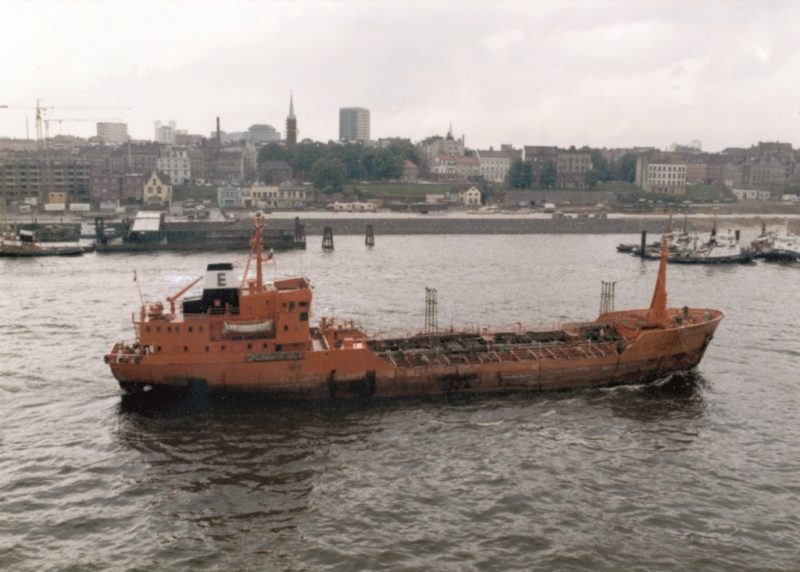
SUMMARY
The Souter family of Newcastle had owned and managed ships for a century, the total number of owned and managed ships being well over one hundred. Another member of the Souter shipping family, Christopher Souter, had set up in 1996 in Newcastle a new company called Souter Trading Ltd., specialising in the sourcing of industrial spare parts, accessories and equipment in the shipping, oil and gas, electricity and gas utilities, and mechanical, electrical and industrial fields. This Souter company still trades today to continue the Souter name of Newcastle in many business fields.
Overseas Shipholding Group (OSG), which took over the Souter tanker management in 2001, is based in Tampa (Florida) and was founded in 1948. In 1969, under the leadership of Raphael Recanati, OSG began acquiring tankers to transport crude oil from Alaska to West Coast U.S.A. ports. Alaska Tanker Company was created in 1999 by BP Oil (25%), Keystone Shipping Company (37.5%) and OSG America (37.5%) to transport oil from the BP North Slope oilfield to U.S. West Coast ports. OSG took full control of the Alaska Tanker Company on 12th March 2020, with the biggest tankers being a double hull, twin funnelled quartet of 195,000 dwt built by NASSCO at San Diego during 2004/06 as Alaskan Frontier, Alaskan Explorer, Alaskan Adventure and Alaskan Legend.
They have two diesel electric engine rooms, two propellers, and two rudders to provide enhanced reliability on the environmentally sensitive West Coast U.S.A. crude oil route from Valdez in Southern Alaska to Puget Sound, San Francisco and Long Beach. The OSG tanker fleet in late 2022 is over eighty tankers, of which 56 trade internationally while the remainder trade on the American coasts under Jones Act cabotage rules.

None of the many owned and managed bulk carriers and ore carriers of this Newcastle shipping company are left afloat today. The six-hold ore carrier quartet of the Bamburgh Shipping Co. Ltd. of 1959/61 were broken up in 1984 at Setubal (Cheviot), in 1984 at Qingdao in China (Bamburgh Castle), in 1985 at Chittagong (Longstone), with Lindisfarne lasting the longest after a career of 36 years she was broken up in China in 1996. The bulker Sheaf Mount of 1965 was broken up in China in 1986, Sheaf Tyne of 1967 was broken up at Alang in 1996, Dunstanburgh Castle of 1969 was broken up in 1995 in India, Sheaf Royal of 1972 was broken up in 1999, Alnwick Castle of 1974 was broken up at Gadani Beach in 1996, and Ros Castle of 1976 was broken up in 1999. These Tyneside manned ships are very much remembered today with affection by the many seafarers that served for long periods onboard on worldwide voyages.
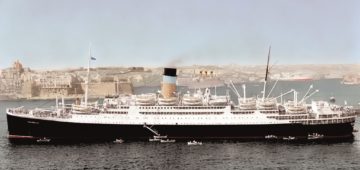



Comments
Sorry, comments are closed for this item